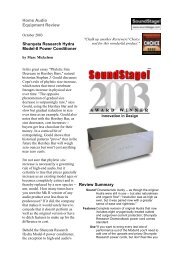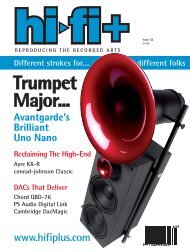Loth X JI 300 translation - Audio Note Singapore
Loth X JI 300 translation - Audio Note Singapore
Loth X JI 300 translation - Audio Note Singapore
You also want an ePaper? Increase the reach of your titles
YUMPU automatically turns print PDFs into web optimized ePapers that Google loves.
Revue du Son et du Home Cinema, number 254, July/August 2001.<br />
<strong>Audio</strong> Dossier, Tube Amplifiers.<br />
<strong>Loth</strong>-X <strong>JI</strong> <strong>300</strong><br />
An exceptional top-of-the-line unit for extracting the quintessence of the latest WE <strong>300</strong>B<br />
triodes.<br />
Specifications<br />
Integrated Amplifier<br />
Nominal Power: 2 x 8 W/ 8 ohm or 16 ohm.<br />
Sensitivity: 350 mV/10 k ohm.<br />
5 high level inputs and monit.<br />
8 and 16 ohm outputs.<br />
Frequency Response<br />
10 Hz – 30 kHz - arpox. 3 dB.<br />
Harmonic Distortion<br />
Equal to or smaller than 2%/1kHz.<br />
Tubes<br />
WE <strong>300</strong>B x 2. 5865 and 5687 x 2.<br />
Dimensions/Weight<br />
430 x 245 x 370 mm. 22 kg.<br />
Origin<br />
<strong>Singapore</strong>/Korea<br />
List Price: 54 900 F/ 8369 Euros (launching price).
Tips for Use<br />
An amplifier, reserved for audio purists, especially for those who are fond of high-fidelity<br />
speakers, particularly the famous <strong>Loth</strong>-X Polaris enclosures.<br />
SINCE its founding in 1998 in <strong>Singapore</strong>, the <strong>Loth</strong>-X society has never ceased being<br />
distinguished for the quality and originality of its creations, which have been consecrated<br />
to the top of the line of the audio world. This old distributor of Lowther speakers,<br />
unsatisfied with existing products, wanted to throw itself into the design and<br />
commercialization of high fidelity speakers, then analog turntables, and finally tube<br />
amplifiers, while all the while never deviating from its purist philosophy. They have<br />
never flinched away from making heavy investments in chassis, networks, presses, and<br />
tools for the manufacture of chassis, speakers, membranes, Alnico magnets, and of the<br />
numerous items that make up their turntables. This perfectionist philosophy has borne<br />
fruit. During the last Hi-Fi salon in Seoul in November 2000, the presentation of the<br />
Silbatone C-102 preamplifier, battery powered and equipped with professional<br />
potentiometers, was followed, over the course of the first three days, with the sale of ten<br />
units. This is all the more impressive considering the hefty price tag of these units, which<br />
is more than justified. <strong>Loth</strong>-X owes its excellent reputation to the competence of several<br />
engineers, particularly Stephan Stamm for speakers. A small detail about the <strong>Loth</strong>-X<br />
brand – the name is not derived from the English brand Lowther, but instead from the<br />
given name of the company’s director, Mr. <strong>Loth</strong>ar Sander.
<strong>JI</strong> <strong>300</strong>: The Top of the Line<br />
Products that are made with as much care as the <strong>Loth</strong>-X <strong>JI</strong> <strong>300</strong> are quite rare.<br />
Accuphase, Nagra, Jeff Rowland, or Cello can be named as exceptions. The most<br />
stunning piece of information is that the <strong>JI</strong> <strong>300</strong> is none other than the little brother of the<br />
top-of-the-line Silbatone <strong>300</strong>SE. The imposing chassis is not made of finely profiled<br />
aluminium, but instead of massive blocks of machined aluminium. A high degree of<br />
precision is omnipresent. <strong>Loth</strong>-X goes so far as to mount the command dials (entry<br />
selector, 40-plot Tokyo-Ko-On attenuator) on ball bearings.<br />
An examination of the interior is even more astonishing. The first thing we notice is the<br />
presence of a large number of top-of-the-line components, designed and manufactured by<br />
<strong>Loth</strong>-X: Slivered-mica condensers, anti-selftic coiled resistors, oiled-paper condensers,<br />
gold double-sided circuit board, silvered connectors. The other big surprise is the very<br />
heart of the chassis – an ultra-quick, ultra-stable power coupling. Its internal resistance is<br />
50 times less than that of a bi-plate valve. This solution, according to <strong>Loth</strong>-X, is the best<br />
approach apart from battery power.<br />
The monotriode circuit delivers a nominal power of 8 W. It makes the best use of the<br />
latest version of the WE <strong>300</strong>B made by the Westrex Corporation. The input stage uses the<br />
5965 double triode, with the second triode mounted in a cathodyne output. The 5687 is<br />
likewise mounted in a cathodyne output. The output transformers, equipped with 8 and<br />
16 ohm sockets, use flat silver wire. What luxury!<br />
-Jean Hiraga
Sound Critique<br />
Test no. 1<br />
Ella Fitzgerald, “Reach for Tomorrow”, Verve Classic Compact, VSCD-4043.<br />
J.H. The silky velvetiness of the medium and high-end registers is a stunning experience.<br />
The spectral balance remains excellent, except for an extreme low-end that retreats a bit.<br />
What a bouquet of qualities!<br />
R.L. The listening experience strikes one with its ethereal and transparent character. The<br />
sonic message is sought. We are incontestably very close to a certain sonic truth. The low<br />
end seemed to me to be on the retreat.<br />
Test no. 2<br />
Mozart, Fantasia for piano, in D minor, Ivo Pogorelich, track 1, DG 437 763-2.<br />
J.H. Sure, the first octaves seem a little light, but they are largely compensated for by an<br />
exceptional richness of timbre. The felt of the hammers, the strings, all are analysed<br />
under a magnifying glass.<br />
R.L. The tonal rendition of the instrument is of the highest calibre. The realism of the<br />
timbres will make you shiver. The left hand is light, perhaps a little too light.<br />
Test no. 3<br />
Applause tests, percussion, NRDS no. 10, tracks 14, 17, and 21.<br />
J.H. There again, the bass comes out with a suggestion of lightness, but it’s largely<br />
compensated for by the high definition. The bells are sublime.<br />
R.L. The <strong>Loth</strong> performs miracles in terms of definition. It’s a magnifying glass of the<br />
highest quality that forgives nothing. The only thing missing is a more consistent base.
Test no. 4<br />
Mark Curry, It’s only time, “All over me”, Virgin CDVUS 49.<br />
J.H. The slight lack of base in the bass and the boosted definition have the effect of<br />
rejuvenating Mark Curry’s voice. The lesser analysed details are unusual.<br />
R.L. Mark Curry is missing some thickness, but not any humanity. This phenomenon is<br />
accentuated bye the analytic side in the high end of the spectrum.<br />
Test no. 5<br />
Johann Strauss, Egyptian March, Op. 335, Das Mikrofon, Tacet 17.<br />
J.H. Without fear of being contradicted, we can speak of a truly rare level of transparency<br />
here, especially on the part of the <strong>300</strong>B that we thought we knew. It’s all at once ultradefined<br />
and soft.<br />
R.L. The tonal palette is quite diversified. Each instrument in the orchestra seems to have<br />
rediscovered its true colour.<br />
Measurements<br />
<strong>Loth</strong>-X <strong>JI</strong> <strong>300</strong> Amplifier<br />
No. 200/1603<br />
Sensitivity: 350 mV<br />
Nominal Power: 2 x 8 W/8 ohm.<br />
Degree of Harmonic Distortion at:<br />
2 W/40 Hz: 2.1%<br />
2 W/1 kHz: 1.7%<br />
2 W/15 kHz: 1.6%<br />
Signal/Noise Ratio, unbalanced: 98 dB.<br />
Time to Climb, 10 kHz square wave: 4.5 micro s.
Results: The power tension flattens out lightly superior at 420 V, the obtained nominal<br />
power is in the order of 8 W. The degree of obtained distortion is linked to the absence of<br />
C.R.<br />
Sine wave shape at 1 kHz/2 W.<br />
We obtained a signal devoid of parasites and instabilities thanks to the stabilized power<br />
coupling. Predominance of paired harmonics.<br />
Square wave shape at 40 kHz/ 2 W.<br />
Results: The incline of the levels is normal, we encounter it in the vast majority of<br />
monotriode mounts.<br />
Square wave shape at 15 kHz/2 W.<br />
Results: The response in the ultrasonic domain of the output transformer is due to the<br />
formation of over-oscillations below 15 kHz.<br />
Overall Evaluation<br />
Jean Hiraga<br />
Decidedly, <strong>Loth</strong>-X is a brand that never ceases to surprise us. Examined up close, this<br />
amplifier is crammed with ideas, halfway between tradition and revolution. With the WE<br />
<strong>300</strong>B on one side, an ultra fast power cut on the other, the whole thing is topped off with<br />
some very rare and costly components (the Toko attenuator of the same version is sold in<br />
Japan for more than 4000 F!). The important thing is to recognize that the result is<br />
indisputably there: an unequalled richness of timbre. Only one weak point: a low end of<br />
the spectrum that is a bit short, although it is rich in detail. Stunning!<br />
Robert Lacrampe<br />
This superb amplifier is more than stunning. It teems with cleverness, and will surprise<br />
more than one audiophile who is used to the <strong>300</strong>B. The abundance of harmonics and the<br />
profusion of details are above the rest. It’s only missing a bit of weight in the bottom end
or it would be the set we would take with us to a desert island. It’s too bad that the price<br />
tag, high but justifiably so, prevents us from bestowing our Recommendation.<br />
Valuation<br />
Subjective Dynamic 9/10<br />
Definition 10/10<br />
Stereophonic Effect 10/10<br />
Set coherence 9/10<br />
Price/quality Ratio 10/10<br />
We liked:<br />
The “wild” aspect of the concept, with totally stunning results to compensate.<br />
We would have appreciated:<br />
More power. More consistent bass register.



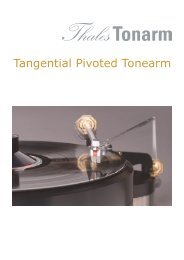

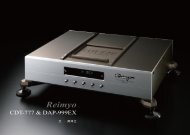

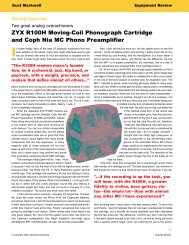
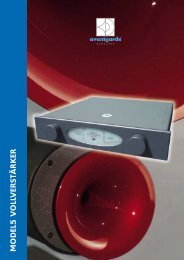

![DAP-999 EX Limited [pdf] - Audio Note Singapore](https://img.yumpu.com/27191044/1/190x253/dap-999-ex-limited-pdf-audio-note-singapore.jpg?quality=85)
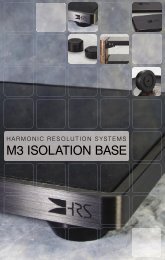
![Harmonix CS-120 Improved-Version [pdf]](https://img.yumpu.com/24411255/1/184x260/harmonix-cs-120-improved-version-pdf.jpg?quality=85)
